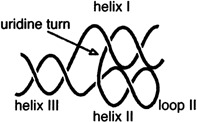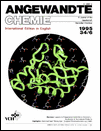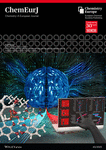Journal list menu
Export Citations
Download PDFs
Cover Picture (Angew. Chem. Int. Ed. Engl. 6/1995)
- First Published: March 31, 1995

The cover picture shows a schematic representation of the X-ray structure (green) of the staphylococcal nuclease mutant Glu → homoglutamate (yellow) in the foreground. This mutant containing one unnatural amino acid was prepared biosynthetically by using the new method of oligonucleotide-directed mutagenesis. The procedure introduces defined, site-specific structural changes that facilitate physicalorganic studies on this important class of macromolecules. In the background are examples of several of the over one hundred non-proteinogenic amino acids that have been successfully incorporated into proteins, including aspartate aminotransferase, methionine aminopeptidase, ribonucleotide reductase, ras p21, staphylococcal nuclease, and T4 Iysozyme. More about the methodology and its application is reported by P. G. Schultz et al. on pages 620 ff.
Graphical Abstract (Angew. Chem. Int. Ed. Engl. 6/1995)
- Pages: 613-618
- First Published: March 31, 1995
Reviews
Probing Protein Structure and Function with an Expanded Genetic Code
- Pages: 621-633
- First Published: March 31, 1995
Through site-specific, oligonucleotide-directed mutagenesis of DNA, in which a selected codon is replaced with the nonsense codon UAG, and with suppressor tRNA containing the codon AUC and acylated with an unnatural amino acid, a prescribed amino acid can be incorporated selectively in proteins and peptides generated by an in vitro protein-synthesizing system, for instance that of E. coli. This general approach allows direct manipulation of proteins. For example, a specific amino acid can be replaced by a residue with slightly different steric or electronic properties for the detailed study of issues such as protein stability and structure, protein–protein interactions, and enzymatic catalysis. Amino acids containing biophysical probes can also be introduced.
Preparative Solid-State Chemistry with High-Power CO2 Lasers
- Pages: 634-640
- First Published: March 31, 1995
Metastable, “entropy-supported”, high-temperature compounds, namely substances with anomalous oxidation states and those with macroscopic defects, have become accessible since the introduction of the CO2 laser. Without doubt, the preparation of such compounds requires a great deal of experimental skill with elaborate apparatus. Following the use of medium-power CO2 lasers in the 1980s, the high-power CO2 lasers now available can reach reaction temperatures of 3000°C. These high-power lasers have been used to synthesize new oxotitanates and oxoniobates.
Highlights
Direct On-Line Coupling of Capillary Electrophoresis and 1H NMR Spectroscopy
- Pages: 641-642
- First Published: March 31, 1995
Nanoliter NMR probes enabled the direct coupling of capillary electrophoresis with 1H NMR spectroscopy to be realized for the first time. How effective this combined technique will be and whether analytical problems can be solved with it depends on the further development of the coil design, since the resolution achieved to date is too low.
The Three-Dimensional Structure of Hammerhead Ribozymes†
- Pages: 643-645
- First Published: March 31, 1995

Two methods—one result: Through fluorescence energy transfer measurements and an X-ray structure analysis on ribozyme–substrate complexes, the groups of Eckstein and McKay independently arrived at a largely consistent structural model for hammerhead ribozymes. Three helices are arranged in a stretched Y shape (see picture) and are stabilized by unusual interactions besides the Watson-Crick base pairing.
Communications
Sequential Transformation of Benzothiopyrylium Salts to Diastereoselectively Annulated Benzothiopyranones†‡
- Pages: 647-649
- First Published: March 31, 1995

As many as three stereogenic centers were introduced in one step in the preparatively simple cascade reaction of 1-benzothiopyrylium salts with 2-siloxy-1,3-butadienes. The cascade comprises 1,2-additions and subsequent intramolecular 1,4-additions and gives the all-cis-thioxanthon rac-3 in 91% yield from the starting compounds 1 and 2, formed in situ. A diastereoselective synthesis of such compounds was not previously known.
Structure Determination in the Twilight Region Between Monolayers and 3-D Crystals; a Grazing Incidence X-Ray Diffraction Study of Nanocrystalline Aggregates of α,ω-Docosanediol at the Air–Water Interface†
- Pages: 649-652
- First Published: March 31, 1995

Double layers are formed by α,ω-docosanediol (C22 diol) when it is spread on a water surface. The space group (a slightly relaxed form of P21/a) and the lattice parameters of the unit cell were determined by X-ray diffraction. Furthermore, multilayer formation was inhibited by addition of 10% of C24H49OH or 5% of HO(CH2)22OCH2Ph to the spreading solution. The coverage with the double layer was reduced to less than 15%; the rest was occupied by a monolayer.
On the Mechanism of Action of Urocanase: Observation of the Enzyme-Bound NAD+ -Inhibitor Adduct by 13C NMR Spectroscopy†
- Pages: 652-654
- First Published: March 31, 1995

Not the aromatic form 1 a but the nonaromatic form 1b of the enzyme-inhibitor complex is preferred at the active site of urocanase. This can be observed in situ with 13C-labeled components by NMR spectroscopy. The enzyme-bound adducts were characterized by use of (4-13C)NAD+-containing urocanase and the labeled inhibitor (5′-13C)imidazolepropionate. • = 13C, R = adenosine diphosphate ribosyl.
[R3Si-arene]+ σ Complexes in the Gas Phase†
- Pages: 654-655
- First Published: March 31, 1995
A Co3 Complex Containing a Bent Trimetal Chain, and Other 1,1′-Ferrocenedithiolato Complexes†
- Pages: 656-657
- First Published: March 31, 1995

A versatile ligand system capable of acting as a two-four-, and six-electron ligand in Cp* complexes of the cobalt triad is the bulky 1,1′-ferrocenedithiolato ligand [S2fc]. In the Co3 complex 1, [S2fc] bridges the CoCo bonds symmetrically and functions as a six-electron donor. The unusual bent Co3 chain in 1 has been structurally characterized.
Heteroatom-Substituted Bicyclo[1.1.1]pentanes with Two Boron Atoms as Electron-Deficient Centers†‡
- Pages: 657-660
- First Published: March 31, 1995
Silicon-Bridged Macrocycles—Synthesis of Sila-calixarenes†
- Pages: 661-662
- First Published: March 31, 1995

Readily available starting materials can be used to prepare silicon-bridged macrocycles of different ring sizes by deprotonation and reaction with Me2SiCl2. While heterocycles such as furan or thiophene gave sila[14]- and sila[16]phanes, para-(tert-butyl)methoxybenzene afforded the first silacalix-[4]arene 1.
Molecular Recognition of Terephthalic Acid by Supramolecular Self-Assembly of an Acridine-Pendant Cyclen–ZnII Complex†
- Pages: 663-664
- First Published: March 31, 1995

An insoluble complex formed by self-assembly: Terephthalate and an acridine-substituted cyclen–ZnII complex react to give the 2:1 complex 1, which results in a supramolecular chainlike aggregate, insoluble in water, that is held together by intermolecular hydrophobic interactions. Since the other phthalate isomers do not behave in this way, it is possible to separate terephthalate selectively.
Coupling of Endothermic Thermal Cracking with Exothermic Oxidative Dehydrogenation of Ethane to Ethylene Using a Diluted SrO/La2O3 Catalyst
- Pages: 665-666
- First Published: March 31, 1995
The energy-efficient and safe conversion of ethane into ethylene is possible by simultaneous exothermic oxidative dehydrogenation and endothermic cracking of ethane in the presence of steam and limited amounts of O2, by using the thermally and hydrothermally stable supported catalyst SrO/La2O3/SA 5205 diluted with an inert support. Because the exothermic and endothermic reactions are coupled, this process requires only very little or no applied energy.
31P CP/MAS NMR Spectroscopy of Transition Metal Phosphane Complexes: “J-Recoupling” between Chemically Equivalent 31P Nuclei in Polycrystalline Compounds of the Type trans-[(PR3)2MX2], MPd, Pt†
- Pages: 667-669
- First Published: March 31, 1995
Minor modification—large effect: Replacement of Et3P by nBu3P in otherwise homologous complexes of the type 1 can dramatically change the solid-state NMR properties. The reason is that–although both compounds show 31PA2 spin systems in solution–only in one case are the 31P nuclei also magnetically equivalent in the solid state. Therefore a reliable interpretation of the high-resolution solid-state 31P NMR spectra must take into consideration the orientation-dependent interactions within the 31P spin pair.
μ-Nitridodiiron Complexes with Asymmetric [FeIVN-FeIII]4+ and Symmetric [FeIVNFeIV]5+ Structural Elements†
- Pages: 669-672
- First Published: March 31, 1995
![μ-Nitridodiiron Complexes with Asymmetric [FeIVN-FeIII]4+ and Symmetric [FeIVNFeIV]5+ Structural Elements](/cms/asset/5e303d93-24b3-4848-98c7-bbb3fa7bc0c2/must001.jpg)
Very strong antiferromagnetic coupling exists between the Fe centers in the N-bridged complexes 1 and 2. In 1 (shown on the right), which contains a symmetrical [FeIV = N = FeIV] unit, this results in an S = 0 ground state, while in 2, which has an unsymmetrical FeIII–N = FeIV bridge, it leads to an S = 3/2 ground state. Compound 2 forms in the photolysis of [FeIII(cat)N3] and can be oxidized with Br2 to give 1. L = trimethyltriazacyclononane, cat = tetrachlorocatecholate(2−).
Lanthanoid Complexes with [(dad)Li] Ligands—New Starting Materials for Organolanthanoid Chemistry†
- Pages: 673-676
- First Published: March 31, 1995
![Lanthanoid Complexes with [(dad)Li] Ligands—New Starting Materials for Organolanthanoid Chemistry](/cms/asset/5f30efb4-0ada-499d-a921-9d08c87c1ca2/must001.jpg)
Easy to synthesize and highly soluble are the new (1,4-diaza-1,3-diene) complexes 1 and 2, which can be considered as alternative starting materials to the frequently used cyclopentadienyl lanthanoid halides in organolanthanoid chemistry. The similarity of Cp ligands and the [(dad)Li]- unit is apparent in the structure of 1 on the right; complexes 2 have a different structure as a result of the smaller ionic radius of the lanthanoid.
Carbenoid Transfer to Imines: A New Asymmetric Catalytic Synthesis of Aziridines†
- Pages: 676-678
- First Published: March 31, 1995
Titanium-Induced Zipper Reactions†
- Pages: 678-681
- First Published: March 31, 1995

Remarkably high chemo- and regioselectivity was found in the intramolecular one-pot McMurray-type reaction between ketone and amide carbonyl groups. A simple preparative method is used by which the active low-valent titanium species is formed selectively at the site of the reductive coupling. For example, compound 2 is formed from 1 in 86% yield by a zipper-like series of carbonyl couplings.
A μ-η6: η6-1,3,5-Triboratabenzenebis(cyclopentadienylcobalt) Triple-Decker Complex†‡
- Pages: 681-683
- First Published: March 31, 1995

A CpCo-induced hydrogen migration and elimination in 1 gives rise to the olive-green, paramagnetic triple-decker complex 2 with the new 1,3,5-triboratabenzene bridging ligand. The B3C3 ring is planar and the BC distances almost the same length. Compound 2 may be easily oxidized with AgBF4 to the diamagnetic 2+BF .
.
Tetraphenanthro[9,10-b:9,10-g:9,10-l:9,10-q]-porphyrin, a New Highly Conjugated Porphyrin System†
- Pages: 683-685
- First Published: March 31, 1995
![Tetraphenanthro[9,10-b:9,10-g:9,10-l:9,10-q]-porphyrin, a New Highly Conjugated Porphyrin System](/cms/asset/130ecc61-b129-4bd5-86fa-cfc5cfcdfc7d/must001.jpg)
Cyclotetramerization of a hydroxymethylphenanthropyrrole afforded a highly conjugated porphyrin 1 with four annelated phenanthrene rings. The 68 carbon atoms in the dication of this highly symmetrical heptadecacycle–the neutral compound is virtually insoluble in most organic solvents–produced only nine resonances in the 13C NMR spectrum.
Topochemical Reaction Control in Solution†‡
- Pages: 685-687
- First Published: March 31, 1995
The Synthesis and Crystal Structures of RbC(SiMe3)3 and CsC(SiMe3)3·3.5 C6H6: A One-dimensional Ionic Solid and an Ionic Solid with a Molecular Structure†
- Pages: 687-688
- First Published: March 31, 1995

The alkali metal compounds MR (R = C(SiMe3)3, M = Rb, Cs), which are extremely air- and moisture-sensitive, can be synthesized from RH and MMe. Crystals of RbR consist of linear chains of Rb+ ions and distorted planar R- ions, whereas those of CsR contain isolated ion pairs surrounded by lattice C6H6 solvent molecules (shown on the right).
Synthesis and Structure of 1-Aza- and 1-Phospha-2-titanacyclobut-4-enes†‡
- Pages: 688-690
- First Published: March 31, 1995

The reduced electrophilicity of the Ti center resulting from Cp* ligands and sp2 hybridization of the ring-C atoms influences the stability of 1 (XN, P) in such a way that 1-aza- and 1-phospha-2-titanacclobut-4-enes could be characterized by X-ray structure analysis for the first time. The metallacycles 1 are formed by trapping the [Cp TiCCH2] intermediate with tBuCX (XN or P); however, the mechanisms of these reactions differ.
TiCCH2] intermediate with tBuCX (XN or P); however, the mechanisms of these reactions differ.
Deformation of Polymethine Structures by Intermolecular Interactions†
- Pages: 690-692
- First Published: March 31, 1995

The polarization of the polymethine π-electron system by the unsymmetrically arranged BPh ion in 1 is so strong that a distortion of the molecular structure of the dye cation could be proved in the solid state for the first time. The phenyl rings in the vicinity of the polymethine chain positivate the left-hand half of the molecule (shown on the right) with the result that bond length alternation is induced.
ion in 1 is so strong that a distortion of the molecular structure of the dye cation could be proved in the solid state for the first time. The phenyl rings in the vicinity of the polymethine chain positivate the left-hand half of the molecule (shown on the right) with the result that bond length alternation is induced.
A Non-Peptidic Ion Channel with K+ Selectivity
- Pages: 693-694
- First Published: March 31, 1995

The resorcinol–octadecanal cyclotetramer 1 forms an ion channel in planar lipid bilayers. A stable conductance level is observed with well-defined transitions between open and closed states. The channel discriminates K+ from Na+ ions as well as cations from anions (for example, K+ from Cl−), as indicated by permeability ratios of 3 and 20, respectively. Rb+ ions block the K+ ion current.
Triple-Helix Formation of Oligodeoxynucleotides Containing [(3′S,5′R)-2′-Deoxy-3′,5′-ethano-β-D-ribofuranosyl]nucleosides (“Bicyclo-deoxynucleosides”)†‡
- Pages: 694-696
- First Published: March 31, 1995
![Triple-Helix Formation of Oligodeoxynucleotides Containing [(3′S,5′R)-2′-Deoxy-3′,5′-ethano-β-D-ribofuranosyl]nucleosides (“Bicyclo-deoxynucleosides”)](/cms/asset/7dd632ff-1330-4b8c-8a6e-42e520dae44b/must001.jpg)
An enhanced preference for complexing to an RNA complement on the Hoogsteen side of the nucleobase is the consequence of the sugar modification in oligonucleotides of bicyclodeoxyguanosine 3. Furthermore, oligonucleotides containing bicyclothymidine 1 and bicyclodeoxycytidine 2 provide evidence of specific differences in the preferred sugar conformation of the nucleosides in the third strand in DNA triple helices.
Book Reviews
Book Review: Handy for Genetic Engineering: Introduction to Molecular Cloning Techniques. By G. Lucotte and F. Baneyx
- Page: 697
- First Published: March 31, 1995





![[R3Si-arene]+ σ Complexes in the Gas Phase](/cms/asset/18d91585-404a-4590-80da-4c31da626322/must001.jpg)
![Heteroatom-Substituted Bicyclo[1.1.1]pentanes with Two Boron Atoms as Electron-Deficient Centers](/cms/asset/7b486a64-67e6-46ee-b506-469d0390139c/must001.jpg)








































